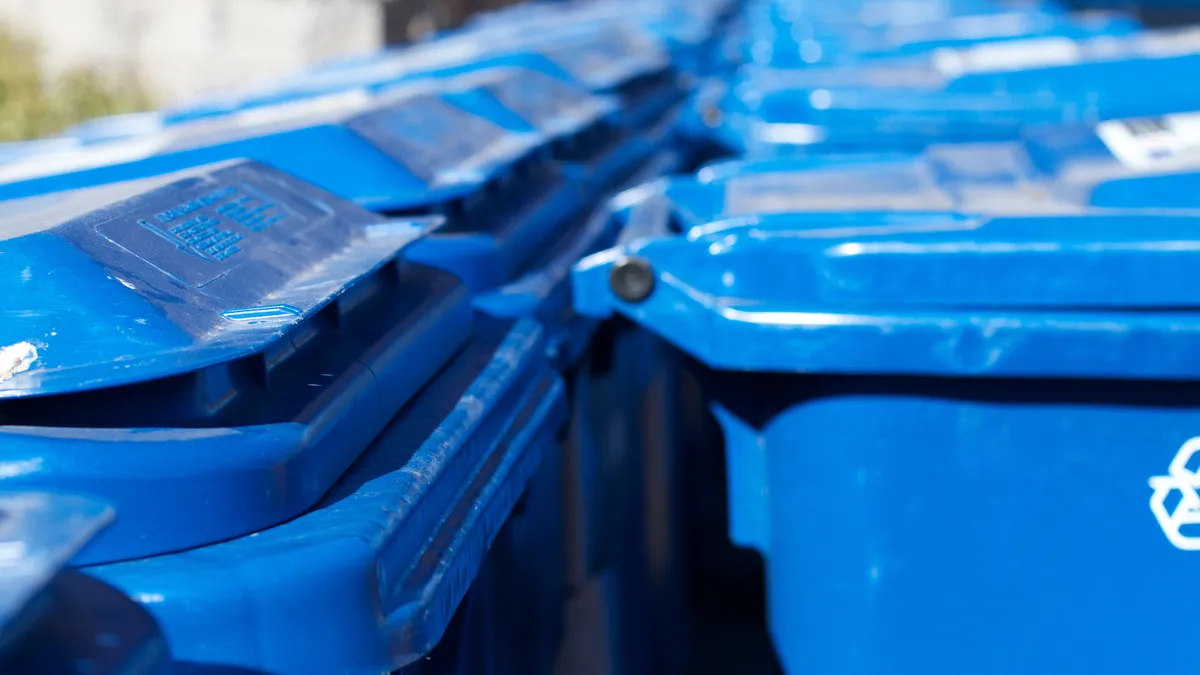Dive Brief:
- Pasadena, California's per capita generation of landfill waste increased by 50% last year over 2012 (from 5.6 to 8.4 lbs. per capita), according to a Public Works Department update on the city's "zero waste" progress.
- According to the report, which was delivered yesterday to the Pasadena City Council's Municipal Services Committee, the city has experienced substantial economic growth since it adopted the Zero Waste Strategic Plan in 2014 — resulting in heightened consumption, real estate development and waste generation.
- Recycling market challenges have also been a factor, according to Public Works. City staff anticipate Pasadena's recycling efforts might be aided by a proposed contract with American Reclamation, which would lower processing costs from $67.60 to $42.24 per ton starting in September.
Dive Insight:
Anchored by core tenets of waste reduction and diversion maximization, Pasadena's "zero waste" plan is anticipated to achieve a minimum of 87% diversion by 2040. The city, which had already attained a 73% diversion rate in 2010, is now "well on the path ... to envisioning a world without waste," according to Public Works — but, as revealed in the update, recycling market volatility has thrown a wrench in its progress.
China's scrap import policy — and its resulting domino effect in Malaysia, Vietnam and other Southeast Asian countries — has "resulted in significant challenges for the solid waste and recycling industry," the report observes. Confronted with strict contamination limits and foreign import bans, California MRFs have been forced to stockpile materials while waiting out market fluctuations.
Pasadena hasn't been immune to these shifts. The city closed all five of its beverage container redemption centers in the face of dipping commodity prices, which — coupled with increases in minimum wage and other federal mandates — made it difficult to pay employees the prevailing wage and benefits.
Furthermore, the report notes that smartphones and tablets have "drastically" reduced the amount of high-value content (i.e., newspapers, magazines, catalogs and junk mail) in the recycling stream. Product packaging has been reengineered to use less material, and plastic content in PET bottles has been halved.
"Since all of our performance metrics are weight based we must now do twice the work to achieve the same diversion," the report reads. This transition to sustainable packaging, it asserts, has increased processing costs and reduced the value of the recycling stream.
Public Works recommends that Pasadena contract with American Reclamation — the successful qualified low bid — in order to better manage costs and set recycling process standards for the residential curbside stream. The contract, extended to a full five-year term, is valued at approximately $1.63 million.
In addition to recycling concerns, the update also highlights organic waste — which, at 40,000 tons per year, forms the largest component of the city's waste stream. According to Public Works, Pasadena's pilot food waste recycling program — implemented at city-managed facilities that generate "significant" food waste — has recycled 3,000 lbs. over the past nine months. The department plans to continue the service, with a goal of expanding to other city facilities in 2020.
Further strategies for residential and commercial organics collection are planned in future years. The city did not respond to a request for comment prior to publication on the residential versus commercial breakdown of its overall landfill waste.
Pasadena's "zero waste" growing pains echo difficulties encountered by other cities — San Francisco's ambitious pledge to achieve "zero waste" by 2020, for instance, was revised to a somewhat less lofty target in August 2018. Los Angeles, on the other hand, has taken the opposite track: the city recently doubled down on its 2013 goal to reach 90% landfill diversion by 2025, adding a new goal to achieve 100% by 2050.















